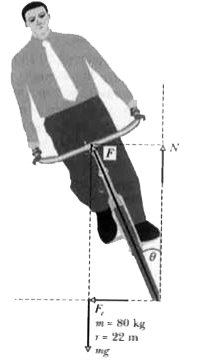A train rounds an unbanked circular bend of radius 30 m at a speed of The mass of the train is kg What provides the centripetal force required for this purpose ? The engine or the rails ? What is the angle of banking required to prevent out the rails ?
The centripetal force is provided by the lateral thrust exerted by the rails on the wheels By Newton s 3 rd law , the train exerts an equal and opposite thrust on the rails causing its wear and tear . Obviously the outer rail will wear out faster due to the larger force exerted by the train on it .
Here
As .
Topper's Solved these Questions
- LAWS OF MOTIONBOOK - PRADEEPCHAPTER - LAWS OF MOTIONEXERCISE - Additional Examples / Exercises
6 Videos
- LAWS OF MOTIONBOOK - PRADEEPCHAPTER - LAWS OF MOTIONEXERCISE - Short Answer Questions
35 Videos
- LAWS OF MOTIONBOOK - PRADEEPCHAPTER - LAWS OF MOTIONEXERCISE - Advanced problems for competitions
20 Videos
- KINEMATICSBOOK - PRADEEPCHAPTER - KINEMATICSEXERCISE - 1 NCERT Comprehension
4 Videos
- MATHEMATICAL TOOLSBOOK - PRADEEPCHAPTER - MATHEMATICAL TOOLSEXERCISE - Fill in the blanks
5 Videos
Similar Questions
An aeroplane requires for take off a speed of 80km/h the run on the ground being 100 m The mass of aeroplane is 104 kg and ground is 0.2 What is the maximum force required by the engine of the plane for take off ?
View SolutionA boy on a bicycle pedals around a circle of 22 m radius at a speed of 10m/s. The combined mass of the boy and the bicycle combined mass of the boy and the bicycle is 80 kg. (a) What is the centripetal force exerted by the pavement on the bicycle? (b) What is the upward force exerted by the pavement on the bicycle? See fig.

View Solution
Knowledge Check
A train of mass 105 kg rounds a curve of radius 100m at a speed of 20 m/s . If the track is not , then the thrust on the outer rail of the track is
A2×105NB3×105NC4×105ND5×105NA car of mass 1200 kg is travelling around a circular path of radius 250 m with a steady speed of 72 km/hour. What is its angular momentum ?
A3×106 kg m2/sB4×106 kg m2/sC5×106 kg m2/sD6×106kgm2/sA train has to negotiate a curve of radius 400 m .The speed of the train is 72 km//h. If the distance between the two rails is 1 m ,then the outer rail will be raised over the inner rail by (g=10m/s2)
A15 cmB10 cmC5 cmD2.5 cm
At what should a highway be banked for cars travelling at a speed of 100 km/h if the radius of the road is 400 m and no frictional forces are involved?
View SolutionA car of mass 2500kg is moving in a circular track of diameter 100m with a speed of 72km/h. What is the angular momentum of the car ?
View SolutionA car travels on a flat, circular track of radius 200m at 30ms−1 and has a centripetal acceleration =4.5ms−2. (a) If the mass of the car is 1000 kg , what frictional force is required to provide the acceleration ? (b) If the coefficient of static friction is 0.8, what is the maximum speed at which the car can circle the track ?
View SolutionThe two rails of a railway track are 1.7 m apart. At a circular curve of radius 1.5 km, a train should have an optimum speed of 108 kmph so that there is no side thrust on the outer rail. Find the angle of banking of the track and the elevation of the outer rail above the inner rail .
View SolutionA car of mass kg rounds a curve of radius 250 m at 90 km/h. Find the centripetal force acting on it .
View Solution
